A
Auto Express
Guest
For some time Electric cars have faced two key problems, a limited range and a lack of places to charge. Electric car ranges are extending with each new model launch and battery technology breakthrough but what of the EV charging facilities? Does the UK have the electric car charging infrastructure to support widespread electric car use and could an EV fit in with your lifestyle with the charging infrastructures we have now? These are the questions we hope to answer with this guide to electric car charging and the UK network.
Where to charge
Firstly, most EV owners still plug in at home, at work, or both. Most cars are parked for hours on end outside houses or offices, and it’s the perfect time to top up the battery so you have a full ‘tank’ whenever you need it. A modern 7kW unit will take a Nissan Leaf from flat to full in about four hours, easily achievable during an overnight or working-day charge. If you’re charging from a normal household power supply though, the process will take significantly longer.
• Best electric cars to buy now
These time frames make a 200-mile round-trip commute feasible in the latest electric cars, and it will cost only a few pounds in electricity rather than £20 or more in a diesel. The stumbling block is when you need to go further than the Leaf’s range allows in one journey. How can you get a top-up while out and about? There’s good news and bad news. On the positive side, there are now over 33,000 individual public charging connectors in the UK at something like 12,000 locations where you can top up your batteries – and the number is increasing by the day. In 2011 there were 1,300 connectors, to give you an idea of the rate of expansion. The bad news is that these days charging your electric car or plug-in hybrid at most of these chargers will cost you money.
This is the biggest change in the infrastructure since the rise of the electric car began in earnest, although it wasn’t unexpected. The original system was supported by some manufacturers and extra Government funding helped establish a network of chargers. Ecotricity plumbed rapid chargers into 96 per cent of motorway service stations and every IKEA store, while Chargemaster and others put lower-voltage posts on streets and in car parks.
All were free to use, with only occasional nominal fees needed in some cases to subscribe and receive a special RFID card to allow access. It meant EV owners could top up for nothing when they were out shopping or on a long trip.
Now that plug-in cars have become more popular, however, the networks want some money in exchange for their electricity. While irritating, it does have the effect of discouraging the chargers’ use by anyone who doesn’t need to top up, as it’s much cheaper to plug in at home.
The way in which these points operate is changing, too. In 2019, the UK government called for all new rapid chargers to incorporate contactless payment. With no need for dozens of accounts or loyalty cards, you can feel confident about plugging in to top up away from home.
How long does it take to charge an electric car?
One of the big questions when it comes to electric car ownership tends to be - how long it will take my electric car to charge? As you can imagine with all the different models, charger types and charging networks we'll go into below, the answer is - it depends.
The average EV charging time can be anything from eight hours or more on a normal domestic power supply to less than an hour with a high-voltage rapid charger. The important thing to remember is that if an electric car suits your lifestyle, you'll be able to charge it at times when you're not using it so the length of time it takes to charge shouldn't really be an issue. We explain more below...
Types of electric vehicle charger
Different EVs require different chargers, and unfortunately there’s not a single car-charging adaptor that allows you to plug in anywhere – unless you’re relying on the slowest form of charger supplied with most EVs as basic equipment, which will generally plug in to a standard three-pin domestic socket.
Commercial or corporate charger installations may look very different to one another, because they are manufactured and installed by different networks. However it’s generally the speed of charge your car can handle that determines which type of charger and connectors you need. Here’s an overview of the three main types...
1) Slow chargers
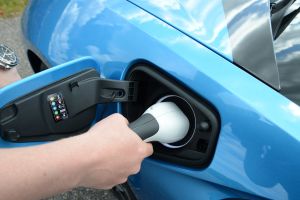
BMW i8 UK charger
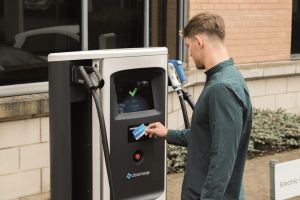
Electric car charging in the UK - Chargemaster Ultracharge rapid charger
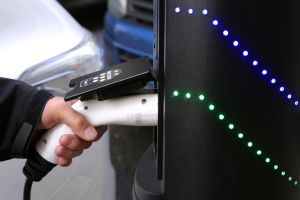
Electric car charging in the UK - Chargemaster public charge point

image

Fun in PHEVs - i8 charging
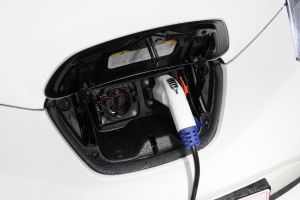
Electric car charging in the UK - Leaf plugged in
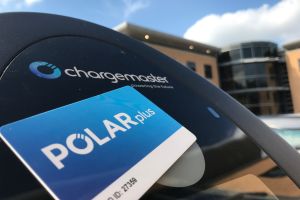
Electric car charging in the UK - Polar Plus
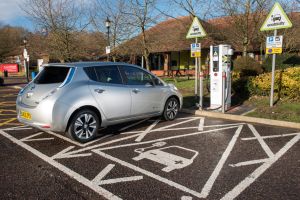
Electric car charging in the UK - Nissan Leaf
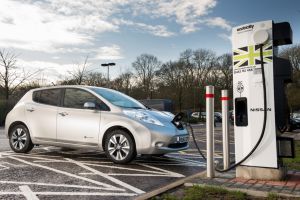
Electric car charging in the UK - header
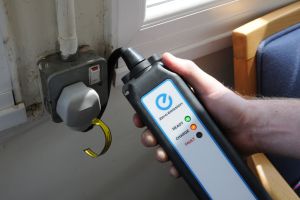
Electric car charging in the UK - Nissan Leaf home charging
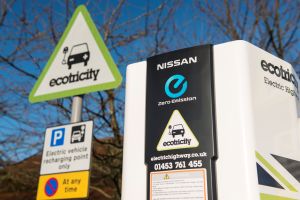
Electric car charging in the UK - charging station
The basic charger supplied with most electric cars and plug-in hybrid cars allows you to charge overnight using a standard 13-amp three-pin plug – although some come with a ‘Commando’ type plug for weatherproof outdoor applications. A typical maximum current draw of 3kW means a full charge usually requires up to eight hours in smaller models but a big electric car with a large battery, such as the Jaguar I-Pace is likely to take in excess of 24 hours to get back to full capacity.
This might be OK if you have a small EV and you park off-street at home where you can plug-in overnight, or if you have a charge point at work you can connect to all day. However, it’s obviously next to useless if you need to top-up your batteries on the motorway or away from home, although EV drivers always carry their 13-amp charger as a last resort!
2) Fast chargers

BMW i8 UK charger

Electric car charging in the UK - Chargemaster Ultracharge rapid charger

Electric car charging in the UK - Chargemaster public charge point

image

Fun in PHEVs - i8 charging

Electric car charging in the UK - Leaf plugged in

Electric car charging in the UK - Polar Plus

Electric car charging in the UK - Nissan Leaf

Electric car charging in the UK - header

Electric car charging in the UK - Nissan Leaf home charging

Electric car charging in the UK - charging station
Fast chargers double the rate of charge you can pump into an EV’s battery, and thereby halve the typical ‘fully charged’ time to three or four hours. Fast chargers operate at up to 7kW and 32 amps and this is the maximum speed of the wallbox chargers that you can have installed at home. The connectors used to plug into Fast Chargers are usually the Type 2 ‘Mennekes’ units, that look like much beefier evolutions of the basic ‘Commando’ units with seven pin holes, and a flat top so you can’t plug them in upside down.
In 2014, the European Commission ruled that all new plug-in vehicles and charging stations should feature Type 2 connectors. New plug-in vehicles now feature Type 2 sockets as standard, but a single car may be compatible with multiple cables. For example, a cable with a Type 2 connector at one end may have a different connector at the other, allowing it to plug into some power sources, but not others. Not all plug-in cars come with a Type 2 cable as standard, either; some manufacturers force you to buy them as an option.
3) Rapid chargers

BMW i8 UK charger

Electric car charging in the UK - Chargemaster Ultracharge rapid charger

Electric car charging in the UK - Chargemaster public charge point

image

Fun in PHEVs - i8 charging

Electric car charging in the UK - Leaf plugged in

Electric car charging in the UK - Polar Plus

Electric car charging in the UK - Nissan Leaf

Electric car charging in the UK - header

Electric car charging in the UK - Nissan Leaf home charging

Electric car charging in the UK - charging station
Most modern electric cars have more advanced electronics that can take a faster charge - up to 120kW in the case of Teslas using the brand's Supercharger network, which is why you can charge a Model S battery up to 80 per cent of its full capacity in ‘just’ half an hour or even more in the case of the latest rapid chargers.
Tesla Supercharger Stations use a proprietary plug that means rival electric car brands can’t use them, but other Rapid Chargers use CHAdeMO and CSS-type plugs, which are respectively Japanese- and Euro-spec connectors, and compatible with a bigger range of electric cars. (Tesla is reportedly heading down the CCS path for future models too.) Most other EVs that are rapid charge compatible can take 50kW.
While no new car currently supports the Ionity network’s 350kW rapid charging speeds, the Porsche Taycan’s 270kW maximum comes close. Connecting this model to one of these rapid chargepoints will see range jump from 10-80 per cent in just 20 minutes. The same task on a Jaguar I-Pace (100kW maximum) will take roughly 45 minutes. Most electric cars will automatically slow their charge rate once they reach 80 per cent, in order to protect battery health and longevity.
The UK’s electric car charging networks
Drivers coming from petrol or diesel models will be used to the simplicity of stopping at a filling station to refuel their cars. However, while you’ll need to factor in more time to top up an EV, the basic process isn’t all that dissimilar. What’s more, there are thousands of charging stations situated in convenient locations and on major trunk roads throughout the UK.
Smartphone apps such Zap-Map make these public chargers easy to find, while Apple Maps will be adding electric-vehicle routing to help you find your nearest plug. It’s worth noting that while many services require an account and payment details, as part of its Road to Zero initiative, the UK Government recently called for all newly installed rapid or higher-powered electric car charging points to be fitted with contactless bank card readers.

BMW i8 UK charger

Electric car charging in the UK - Chargemaster Ultracharge rapid charger

Electric car charging in the UK - Chargemaster public charge point

image

Fun in PHEVs - i8 charging

Electric car charging in the UK - Leaf plugged in

Electric car charging in the UK - Polar Plus

Electric car charging in the UK - Nissan Leaf

Electric car charging in the UK - header

Electric car charging in the UK - Nissan Leaf home charging

Electric car charging in the UK - charging station
This makes public charging much simpler, and it’s clear that consumers rate this kind of tech very highly. InstaVolt – a no account, pay-as-you-go EV charging network – ranked second in our most recent Driver Power chargepoint survey .
However, many operators offer preferential rates to customers who’ve signed up to use their services. Polar (owned by BP Chargemaster), for example, offers three charging options: Polar Plus commands a monthly fee, but opens up access to hundreds of free-to-use chargers, as well as low rates of as little as 12p/kWh for its fast and rapid chargepoints. Polar Instant is more expensive – with a minimum payment per transaction – while those covering even fewer zero-emission miles can make use of Polar’s rapid chargers using their contactless bank card.
Electric car drivers will know it’s advisable to check out both the availability of charge points on their proposed journeys, and also which network operates them in order to make the fastest and most cost-effective journey.
How much do public EV chargers cost to use?
If you want to charge in transit, it;s helpful to have a smartphone. Despite the requirement for new chargers to have contactless payment options, most networks have apps that can help you find chargers and manage your costs. You can download them while sat in the car.
Some apps merely ask for your credit or debit card info, and will charge you based on time and power used. The phone sends commands directly to the point, telling it to start and stop, and to open access flaps.
Access and electricity costs vary. Some venues such as hotels and shopping centres give power away for free, but most posts cost around £1.50 per hour. Rapid chargers are generally more expensive, reflecting the fact that they can cram more electricity into the battery in a shorter time. An Ecotricity charger at a motorway service station will cost £3 to connect for up to 45 minutes, plus 30p for each kWh of electric. Ecotricity home-energy customers get a discount. Other rapid chargers, such as those at some Shell stations, simply charge for the electricity. Currently the rate is 39p/kWh.

BMW i8 UK charger

Electric car charging in the UK - Chargemaster Ultracharge rapid charger

Electric car charging in the UK - Chargemaster public charge point

image

Fun in PHEVs - i8 charging

Electric car charging in the UK - Leaf plugged in

Electric car charging in the UK - Polar Plus

Electric car charging in the UK - Nissan Leaf

Electric car charging in the UK - header

Electric car charging in the UK - Nissan Leaf home charging

Electric car charging in the UK - charging station
It makes sense for regular charger users to forget pay-as-you-go and instead pay a monthly subscription to a service such as the Polar network. This speeds up access and makes charger use either free or far cheaper. Most will find it’s better value for money if they require a rapid charge more than once a month, or a standard top-up once a week. There are ways to rapid charge for free, though. Some dealers will let you use their chargers for free during working hours, and IKEA stores will refund the Ecotricity cost if you spend in store. Don’t get excited by the rows of Tesla Supercharger points that are popping up, though – they work only with Tesla cars.
Is it worth all the effort? If you have access to charging at home or work, you’ll be able to run an electric car for a fraction of the cost of a petrol or diesel car. If you charge at public points only, the savings will be far less, and there’s the extra stress of finding a spot. However, if you merely use these chargers for the occasional long trip, the growing network – plus the increased range of EVs – is making these cars a practical proposition for thousands more motorists.
Now find your EV charger…
It would be foolhardy to undertake a journey of any significance in an electric car without planning ahead. If you are a member of a network you’ll already be familiar with local charger locations, and probably also a user of that provider’s website or phone app where all its charging locations will be listed.
For travel outside your network, you need to access one of the websites like Zap Map or Open Charge, which claim to list all the public chargers across the UK. They also offer specific information about the equipment on offer, the cost to plug in, and the operational status of every charging facility.
Useful as it is, online information is user-generated in a proportion of cases, and not always up to date. So we’d recommend taking the precaution of personally contacting potential charging stations ahead of your arrival. You’ll want to make sure they’re functional and suited to the vehicle you’re driving, unless there are multiple options in the area.

BMW i8 UK charger

Electric car charging in the UK - Chargemaster Ultracharge rapid charger

Electric car charging in the UK - Chargemaster public charge point

image

Fun in PHEVs - i8 charging

Electric car charging in the UK - Leaf plugged in

Electric car charging in the UK - Polar Plus

Electric car charging in the UK - Nissan Leaf

Electric car charging in the UK - header

Electric car charging in the UK - Nissan Leaf home charging

Electric car charging in the UK - charging station
Top tips for EV charging
1. Get a good home charger
A home charging point will usually be fitted for free when you buy the car, thanks to Government grants to encourage EV use. You may want to upgrade to a 7kW charger if your car has the capacity to accept it, or if you want to ‘future proof’ your installation for an upgraded car you may one day purchase.
2. Get a good electricity deal
Check your electricity supplier’s prices. It makes sense to move to a deal that has the lowest price per kWh but a higher standing charge, as you will become a heavy user. If you will charge your car mostly at night, consider an Economy 7 meter with cheaper rates in the early hours. The Leaf has a programmable charging timer that can make the most of this.
3. Plan ahead
If you plan longer journeys carefully, they needn’t be stressful. A Leaf’s satellite navigation lists charge points, but websites such as Zap Map or Open Charge are more detailed, telling you what type it is and whether it’s currently working.
4. Check your phone reception

BMW i8 UK charger

Electric car charging in the UK - Chargemaster Ultracharge rapid charger

Electric car charging in the UK - Chargemaster public charge point

image

Fun in PHEVs - i8 charging

Electric car charging in the UK - Leaf plugged in

Electric car charging in the UK - Polar Plus

Electric car charging in the UK - Nissan Leaf

Electric car charging in the UK - header

Electric car charging in the UK - Nissan Leaf home charging

Electric car charging in the UK - charging station
When using a public charge point controlled by an app, make sure your mobile phone reception is good enough to receive data. Otherwise you could be waiting a while for the instructions to reach the charge post. It’s especially a problem in multi-storey car parks or places with a lot of people, such as concerts and theme parks.
5. Be polite
EV owners are generally friendly, and most will move off a charging spot once they have enough power to get home – leaving it free for another driver to use. Make sure you follow this etiquette, too, or you could be seriously inconveniencing someone.
6. On the spot
Despite clear markings and the threat of fines, some internal-combustion engine car drivers still park in EV charging spots. In the EV community it’s know as being ‘ICEd’, and there are Twitter and Facebook pages dedicated to shaming offenders. If you really need to charge and are blocked, ask the service station or shop staff to make an announcement asking the driver to move.
What is your experience of electric car charging stations in the UK? Let us know in the comments...
Get the latest electric car news, reviews and analysis on DrivingElectric.com
Continue reading...
Where to charge
Firstly, most EV owners still plug in at home, at work, or both. Most cars are parked for hours on end outside houses or offices, and it’s the perfect time to top up the battery so you have a full ‘tank’ whenever you need it. A modern 7kW unit will take a Nissan Leaf from flat to full in about four hours, easily achievable during an overnight or working-day charge. If you’re charging from a normal household power supply though, the process will take significantly longer.
• Best electric cars to buy now
These time frames make a 200-mile round-trip commute feasible in the latest electric cars, and it will cost only a few pounds in electricity rather than £20 or more in a diesel. The stumbling block is when you need to go further than the Leaf’s range allows in one journey. How can you get a top-up while out and about? There’s good news and bad news. On the positive side, there are now over 33,000 individual public charging connectors in the UK at something like 12,000 locations where you can top up your batteries – and the number is increasing by the day. In 2011 there were 1,300 connectors, to give you an idea of the rate of expansion. The bad news is that these days charging your electric car or plug-in hybrid at most of these chargers will cost you money.
This is the biggest change in the infrastructure since the rise of the electric car began in earnest, although it wasn’t unexpected. The original system was supported by some manufacturers and extra Government funding helped establish a network of chargers. Ecotricity plumbed rapid chargers into 96 per cent of motorway service stations and every IKEA store, while Chargemaster and others put lower-voltage posts on streets and in car parks.
All were free to use, with only occasional nominal fees needed in some cases to subscribe and receive a special RFID card to allow access. It meant EV owners could top up for nothing when they were out shopping or on a long trip.
Now that plug-in cars have become more popular, however, the networks want some money in exchange for their electricity. While irritating, it does have the effect of discouraging the chargers’ use by anyone who doesn’t need to top up, as it’s much cheaper to plug in at home.
The way in which these points operate is changing, too. In 2019, the UK government called for all new rapid chargers to incorporate contactless payment. With no need for dozens of accounts or loyalty cards, you can feel confident about plugging in to top up away from home.
How long does it take to charge an electric car?
One of the big questions when it comes to electric car ownership tends to be - how long it will take my electric car to charge? As you can imagine with all the different models, charger types and charging networks we'll go into below, the answer is - it depends.
The average EV charging time can be anything from eight hours or more on a normal domestic power supply to less than an hour with a high-voltage rapid charger. The important thing to remember is that if an electric car suits your lifestyle, you'll be able to charge it at times when you're not using it so the length of time it takes to charge shouldn't really be an issue. We explain more below...
Types of electric vehicle charger
Different EVs require different chargers, and unfortunately there’s not a single car-charging adaptor that allows you to plug in anywhere – unless you’re relying on the slowest form of charger supplied with most EVs as basic equipment, which will generally plug in to a standard three-pin domestic socket.
Commercial or corporate charger installations may look very different to one another, because they are manufactured and installed by different networks. However it’s generally the speed of charge your car can handle that determines which type of charger and connectors you need. Here’s an overview of the three main types...
1) Slow chargers

BMW i8 UK charger

Electric car charging in the UK - Chargemaster Ultracharge rapid charger

Electric car charging in the UK - Chargemaster public charge point

image

Fun in PHEVs - i8 charging

Electric car charging in the UK - Leaf plugged in

Electric car charging in the UK - Polar Plus

Electric car charging in the UK - Nissan Leaf

Electric car charging in the UK - header

Electric car charging in the UK - Nissan Leaf home charging

Electric car charging in the UK - charging station
The basic charger supplied with most electric cars and plug-in hybrid cars allows you to charge overnight using a standard 13-amp three-pin plug – although some come with a ‘Commando’ type plug for weatherproof outdoor applications. A typical maximum current draw of 3kW means a full charge usually requires up to eight hours in smaller models but a big electric car with a large battery, such as the Jaguar I-Pace is likely to take in excess of 24 hours to get back to full capacity.
This might be OK if you have a small EV and you park off-street at home where you can plug-in overnight, or if you have a charge point at work you can connect to all day. However, it’s obviously next to useless if you need to top-up your batteries on the motorway or away from home, although EV drivers always carry their 13-amp charger as a last resort!
2) Fast chargers

BMW i8 UK charger

Electric car charging in the UK - Chargemaster Ultracharge rapid charger

Electric car charging in the UK - Chargemaster public charge point

image

Fun in PHEVs - i8 charging

Electric car charging in the UK - Leaf plugged in

Electric car charging in the UK - Polar Plus

Electric car charging in the UK - Nissan Leaf

Electric car charging in the UK - header

Electric car charging in the UK - Nissan Leaf home charging

Electric car charging in the UK - charging station
Fast chargers double the rate of charge you can pump into an EV’s battery, and thereby halve the typical ‘fully charged’ time to three or four hours. Fast chargers operate at up to 7kW and 32 amps and this is the maximum speed of the wallbox chargers that you can have installed at home. The connectors used to plug into Fast Chargers are usually the Type 2 ‘Mennekes’ units, that look like much beefier evolutions of the basic ‘Commando’ units with seven pin holes, and a flat top so you can’t plug them in upside down.
In 2014, the European Commission ruled that all new plug-in vehicles and charging stations should feature Type 2 connectors. New plug-in vehicles now feature Type 2 sockets as standard, but a single car may be compatible with multiple cables. For example, a cable with a Type 2 connector at one end may have a different connector at the other, allowing it to plug into some power sources, but not others. Not all plug-in cars come with a Type 2 cable as standard, either; some manufacturers force you to buy them as an option.
3) Rapid chargers

BMW i8 UK charger

Electric car charging in the UK - Chargemaster Ultracharge rapid charger

Electric car charging in the UK - Chargemaster public charge point

image

Fun in PHEVs - i8 charging

Electric car charging in the UK - Leaf plugged in

Electric car charging in the UK - Polar Plus

Electric car charging in the UK - Nissan Leaf

Electric car charging in the UK - header

Electric car charging in the UK - Nissan Leaf home charging

Electric car charging in the UK - charging station
Most modern electric cars have more advanced electronics that can take a faster charge - up to 120kW in the case of Teslas using the brand's Supercharger network, which is why you can charge a Model S battery up to 80 per cent of its full capacity in ‘just’ half an hour or even more in the case of the latest rapid chargers.
Tesla Supercharger Stations use a proprietary plug that means rival electric car brands can’t use them, but other Rapid Chargers use CHAdeMO and CSS-type plugs, which are respectively Japanese- and Euro-spec connectors, and compatible with a bigger range of electric cars. (Tesla is reportedly heading down the CCS path for future models too.) Most other EVs that are rapid charge compatible can take 50kW.
While no new car currently supports the Ionity network’s 350kW rapid charging speeds, the Porsche Taycan’s 270kW maximum comes close. Connecting this model to one of these rapid chargepoints will see range jump from 10-80 per cent in just 20 minutes. The same task on a Jaguar I-Pace (100kW maximum) will take roughly 45 minutes. Most electric cars will automatically slow their charge rate once they reach 80 per cent, in order to protect battery health and longevity.
The UK’s electric car charging networks
Drivers coming from petrol or diesel models will be used to the simplicity of stopping at a filling station to refuel their cars. However, while you’ll need to factor in more time to top up an EV, the basic process isn’t all that dissimilar. What’s more, there are thousands of charging stations situated in convenient locations and on major trunk roads throughout the UK.
Smartphone apps such Zap-Map make these public chargers easy to find, while Apple Maps will be adding electric-vehicle routing to help you find your nearest plug. It’s worth noting that while many services require an account and payment details, as part of its Road to Zero initiative, the UK Government recently called for all newly installed rapid or higher-powered electric car charging points to be fitted with contactless bank card readers.

BMW i8 UK charger

Electric car charging in the UK - Chargemaster Ultracharge rapid charger

Electric car charging in the UK - Chargemaster public charge point

image

Fun in PHEVs - i8 charging

Electric car charging in the UK - Leaf plugged in

Electric car charging in the UK - Polar Plus

Electric car charging in the UK - Nissan Leaf

Electric car charging in the UK - header

Electric car charging in the UK - Nissan Leaf home charging

Electric car charging in the UK - charging station
This makes public charging much simpler, and it’s clear that consumers rate this kind of tech very highly. InstaVolt – a no account, pay-as-you-go EV charging network – ranked second in our most recent Driver Power chargepoint survey .
However, many operators offer preferential rates to customers who’ve signed up to use their services. Polar (owned by BP Chargemaster), for example, offers three charging options: Polar Plus commands a monthly fee, but opens up access to hundreds of free-to-use chargers, as well as low rates of as little as 12p/kWh for its fast and rapid chargepoints. Polar Instant is more expensive – with a minimum payment per transaction – while those covering even fewer zero-emission miles can make use of Polar’s rapid chargers using their contactless bank card.
Electric car drivers will know it’s advisable to check out both the availability of charge points on their proposed journeys, and also which network operates them in order to make the fastest and most cost-effective journey.
How much do public EV chargers cost to use?
If you want to charge in transit, it;s helpful to have a smartphone. Despite the requirement for new chargers to have contactless payment options, most networks have apps that can help you find chargers and manage your costs. You can download them while sat in the car.
Some apps merely ask for your credit or debit card info, and will charge you based on time and power used. The phone sends commands directly to the point, telling it to start and stop, and to open access flaps.
Access and electricity costs vary. Some venues such as hotels and shopping centres give power away for free, but most posts cost around £1.50 per hour. Rapid chargers are generally more expensive, reflecting the fact that they can cram more electricity into the battery in a shorter time. An Ecotricity charger at a motorway service station will cost £3 to connect for up to 45 minutes, plus 30p for each kWh of electric. Ecotricity home-energy customers get a discount. Other rapid chargers, such as those at some Shell stations, simply charge for the electricity. Currently the rate is 39p/kWh.

BMW i8 UK charger

Electric car charging in the UK - Chargemaster Ultracharge rapid charger

Electric car charging in the UK - Chargemaster public charge point

image

Fun in PHEVs - i8 charging

Electric car charging in the UK - Leaf plugged in

Electric car charging in the UK - Polar Plus

Electric car charging in the UK - Nissan Leaf

Electric car charging in the UK - header

Electric car charging in the UK - Nissan Leaf home charging

Electric car charging in the UK - charging station
It makes sense for regular charger users to forget pay-as-you-go and instead pay a monthly subscription to a service such as the Polar network. This speeds up access and makes charger use either free or far cheaper. Most will find it’s better value for money if they require a rapid charge more than once a month, or a standard top-up once a week. There are ways to rapid charge for free, though. Some dealers will let you use their chargers for free during working hours, and IKEA stores will refund the Ecotricity cost if you spend in store. Don’t get excited by the rows of Tesla Supercharger points that are popping up, though – they work only with Tesla cars.
Is it worth all the effort? If you have access to charging at home or work, you’ll be able to run an electric car for a fraction of the cost of a petrol or diesel car. If you charge at public points only, the savings will be far less, and there’s the extra stress of finding a spot. However, if you merely use these chargers for the occasional long trip, the growing network – plus the increased range of EVs – is making these cars a practical proposition for thousands more motorists.
Now find your EV charger…
It would be foolhardy to undertake a journey of any significance in an electric car without planning ahead. If you are a member of a network you’ll already be familiar with local charger locations, and probably also a user of that provider’s website or phone app where all its charging locations will be listed.
For travel outside your network, you need to access one of the websites like Zap Map or Open Charge, which claim to list all the public chargers across the UK. They also offer specific information about the equipment on offer, the cost to plug in, and the operational status of every charging facility.
Useful as it is, online information is user-generated in a proportion of cases, and not always up to date. So we’d recommend taking the precaution of personally contacting potential charging stations ahead of your arrival. You’ll want to make sure they’re functional and suited to the vehicle you’re driving, unless there are multiple options in the area.

BMW i8 UK charger

Electric car charging in the UK - Chargemaster Ultracharge rapid charger

Electric car charging in the UK - Chargemaster public charge point

image

Fun in PHEVs - i8 charging

Electric car charging in the UK - Leaf plugged in

Electric car charging in the UK - Polar Plus

Electric car charging in the UK - Nissan Leaf

Electric car charging in the UK - header

Electric car charging in the UK - Nissan Leaf home charging

Electric car charging in the UK - charging station
Top tips for EV charging
1. Get a good home charger
A home charging point will usually be fitted for free when you buy the car, thanks to Government grants to encourage EV use. You may want to upgrade to a 7kW charger if your car has the capacity to accept it, or if you want to ‘future proof’ your installation for an upgraded car you may one day purchase.
2. Get a good electricity deal
Check your electricity supplier’s prices. It makes sense to move to a deal that has the lowest price per kWh but a higher standing charge, as you will become a heavy user. If you will charge your car mostly at night, consider an Economy 7 meter with cheaper rates in the early hours. The Leaf has a programmable charging timer that can make the most of this.
3. Plan ahead
If you plan longer journeys carefully, they needn’t be stressful. A Leaf’s satellite navigation lists charge points, but websites such as Zap Map or Open Charge are more detailed, telling you what type it is and whether it’s currently working.
4. Check your phone reception

BMW i8 UK charger

Electric car charging in the UK - Chargemaster Ultracharge rapid charger

Electric car charging in the UK - Chargemaster public charge point

image

Fun in PHEVs - i8 charging

Electric car charging in the UK - Leaf plugged in

Electric car charging in the UK - Polar Plus

Electric car charging in the UK - Nissan Leaf

Electric car charging in the UK - header

Electric car charging in the UK - Nissan Leaf home charging

Electric car charging in the UK - charging station
When using a public charge point controlled by an app, make sure your mobile phone reception is good enough to receive data. Otherwise you could be waiting a while for the instructions to reach the charge post. It’s especially a problem in multi-storey car parks or places with a lot of people, such as concerts and theme parks.
5. Be polite
EV owners are generally friendly, and most will move off a charging spot once they have enough power to get home – leaving it free for another driver to use. Make sure you follow this etiquette, too, or you could be seriously inconveniencing someone.
6. On the spot
Despite clear markings and the threat of fines, some internal-combustion engine car drivers still park in EV charging spots. In the EV community it’s know as being ‘ICEd’, and there are Twitter and Facebook pages dedicated to shaming offenders. If you really need to charge and are blocked, ask the service station or shop staff to make an announcement asking the driver to move.
What is your experience of electric car charging stations in the UK? Let us know in the comments...
Get the latest electric car news, reviews and analysis on DrivingElectric.com
Continue reading...
